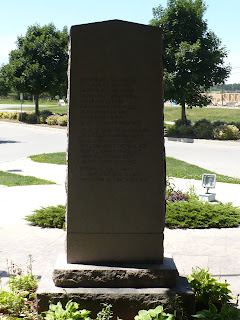
Location: N 44° 33.840 W 080° 56.685 Three plaques are found on the east side of 1st Avenue, across from the library.
Three men from the Owen Sound area have been awarded the Victoria Cross, the highest honour in the British Commonwealth. These three Ontario Historical Plaques are situated side by side, next to the town's cenotaph.
Thomas William Holmes, V.C., 1898-1950
Plaque Text
Born in Montreal, Holmes moved with his family
to Owen Sound in 1903. He enlisted in the 147th Infantry Battalion
C.E.F. in 1915, but later transferred to the 4th Canadian Mounted
Rifles. In October 1917, his unit took part in the violent opening
assault on the German position at Passchendaele. During this action
Private Holmes, under heavy enemy fire, captured single-handed an
important "pill-box" strongpoint which had been holding up the right
flank of the Canadian advance. He was awarded the Victoria Cross for his
valour in this battle.
David Vivian Currie, V.C. 1912-1986


Plaque Text
A much-honoured World War II army officer,
Currie, who is buried in Owen Sound, was born and raised in
Saskatchewan. He enlisted in 1940 and was sent overseas with the 29th
Canadian Armoured Reconnaissance Regiment (the South Alberta Regiment)
three years later. On August 18, 1944, Currie, leading a small force in
Normandy, was ordered to help seal the Chambois-Trun escape route to the
German forces cut off in the Falaise pocket. He met fierce resistance
in the village of St. Lambert-sur-Dives. There, by skilful command and
heroic example, Currie sustained his men for three days as they
repeatedly thwarted breakout attempts by masses of Germans. For his
actions, he was awarded the Victoria Cross, the British Commonwealth's
highest decoration for valour.


Plaque Text
Born in Owen Sound, "Billy" Bishop was
attending the Royal Military College when war was declared in 1914. He
first joined a cavalry unit, but in 1915 transferred to the Royal Flying
Corps. Courage and marksmanship made him one of the war's greatest
fighting pilots, credited officially with the destruction of 72 enemy
aircraft. When hostilities ended he was the youngest lieutenant-colonel
of the air force and had won the Victoria Cross, the Distinguished
Service Order and the Military Cross. During World War II he became a
director of recruiting for the R.C.A.F. with the rank of air marshal.
















































